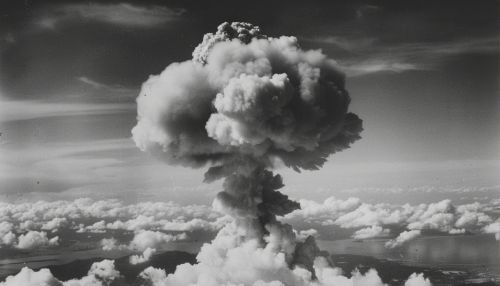Atomic Bomb
Introduction
The atomic bomb, also known as a nuclear bomb, is a weapon of mass destruction that utilizes nuclear reactions to release an immense amount of energy. The development and deployment of atomic bombs have had profound impacts on global politics, warfare, and international relations. This article delves into the scientific principles, historical development, and implications of atomic bombs.
Scientific Principles
Nuclear Fission
The primary mechanism behind an atomic bomb is nuclear fission, a process in which the nucleus of an atom splits into two or more smaller nuclei, along with a few neutrons and a significant amount of energy. The most commonly used fissile materials in atomic bombs are Uranium-235 and Plutonium-239. When a fissile nucleus absorbs a neutron, it becomes unstable and splits, releasing energy and more neutrons, which can then induce fission in other nuclei, creating a chain reaction.
Critical Mass
For a sustained chain reaction, a certain amount of fissile material, known as the critical mass, is required. If the mass of the fissile material is below this threshold, the chain reaction will fizzle out. In an atomic bomb, the design ensures that the fissile material reaches or exceeds critical mass at the moment of detonation.
Explosive Yield
The explosive yield of an atomic bomb is measured in terms of the equivalent amount of TNT (trinitrotoluene). The yield can vary significantly, from a few kilotons (thousands of tons of TNT) to megatons (millions of tons of TNT). The yield depends on the amount of fissile material and the efficiency of the bomb design.
Historical Development
The Manhattan Project
The development of the first atomic bombs was undertaken by the United States during World War II under the code name Manhattan Project. Initiated in 1939, the project brought together some of the greatest scientific minds of the time, including Robert Oppenheimer, Enrico Fermi, and Niels Bohr. The project culminated in the successful detonation of the first atomic bomb, code-named "Trinity," on July 16, 1945, in the New Mexico desert.
Hiroshima and Nagasaki
On August 6, 1945, the United States dropped the first atomic bomb, "Little Boy," on the Japanese city of Hiroshima. Three days later, on August 9, 1945, a second bomb, "Fat Man," was dropped on Nagasaki. These bombings resulted in the immediate deaths of approximately 200,000 people and led to Japan's surrender, effectively ending World War II.


Types of Atomic Bombs
Gun-Type Design
The gun-type design is the simpler of the two primary atomic bomb designs. It involves shooting one sub-critical mass of fissile material into another using conventional explosives. The "Little Boy" bomb dropped on Hiroshima utilized this design.
Implosion-Type Design
The implosion-type design uses conventional explosives to compress a sub-critical sphere of fissile material into a supercritical state. This method is more efficient and allows for the use of Plutonium-239. The "Fat Man" bomb dropped on Nagasaki was an implosion-type bomb.
Effects of Atomic Bombs
Immediate Impact
The immediate impact of an atomic bomb includes a massive explosion, intense heat, and a powerful shockwave. The explosion can obliterate structures and cause widespread fires, while the heat can cause severe burns and ignite flammable materials. The shockwave can cause further destruction and casualties.
Radiation
Atomic bombs release both immediate and residual radiation. Immediate radiation includes gamma rays and neutrons, which can cause acute radiation sickness and death. Residual radiation, also known as fallout, consists of radioactive particles that can contaminate the environment and pose long-term health risks.
Long-Term Effects
The long-term effects of atomic bomb detonations include increased cancer rates, genetic mutations, and environmental contamination. Survivors of the Hiroshima and Nagasaki bombings, known as Hibakusha, have experienced higher incidences of leukemia and other cancers.
Ethical and Political Implications
Deterrence and Mutually Assured Destruction
The existence of atomic bombs has led to the doctrine of Mutually Assured Destruction (MAD), which posits that the use of nuclear weapons by two or more opposing sides would result in the complete annihilation of both the attacker and the defender. This doctrine has been a cornerstone of nuclear deterrence policies.
Non-Proliferation Efforts
In response to the threat posed by nuclear weapons, various international treaties and agreements have been established to prevent their proliferation. The Treaty on the Non-Proliferation of Nuclear Weapons (NPT), signed in 1968, aims to prevent the spread of nuclear weapons and promote disarmament.
Ethical Debates
The use of atomic bombs has sparked ongoing ethical debates. Critics argue that the bombings of Hiroshima and Nagasaki were unnecessary and inhumane, while proponents contend that they were necessary to end World War II and save lives. The ethical implications of nuclear weapons continue to be a topic of intense discussion.
Modern Developments
Advances in Nuclear Technology
Since the development of the first atomic bombs, there have been significant advances in nuclear technology. Modern nuclear weapons are more sophisticated and powerful, with some designs incorporating thermonuclear reactions, also known as hydrogen bombs, which use fusion in addition to fission.
Nuclear Disarmament
Efforts towards nuclear disarmament have been ongoing, with various treaties and agreements aimed at reducing the number of nuclear weapons. The Strategic Arms Reduction Treaty (START) and its successors have been instrumental in reducing the nuclear arsenals of the United States and Russia.
Current Nuclear-Armed States
As of today, nine countries are known to possess nuclear weapons: the United States, Russia, the United Kingdom, France, China, India, Pakistan, Israel, and North Korea. The presence of nuclear weapons in these countries continues to shape global politics and security dynamics.
See Also
- Nuclear Fusion
- Cold War
- Nuclear Fallout
- Radiation Sickness
- Nuclear Reactor
- Nuclear Proliferation
- Thermonuclear Weapon
- Nuclear Disarmament
